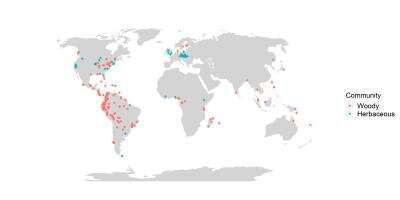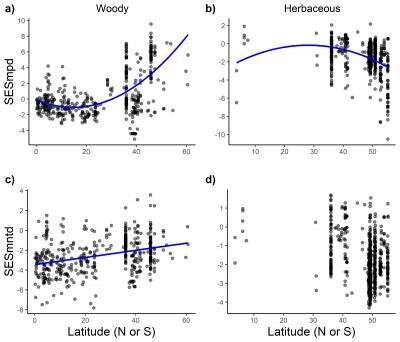Latitudinal gradient of plant phylogenetic diversity explained

Why are there so many species in the tropics? For centuries, scientists have been searching for the causes of the latitudinal gradient in species diversity—a pattern that has been documented for most groups of living species, including plants, insects, birds, and mammals.
Interestingly, an Estonian wooded meadow far in the north of the country holds the world record for species richness with tropical rain forests. Why? A group of scientists from Estonian universities (Massante et al. 2019) asked whether the evolutionary relatedness of species (i.e. phylogenetic diversity), apart from species number, explains these latitudinal patterns.
Massante and colleagues found contrasting latitudinal gradients of phylogenetic diversity between woody and herbaceous communities. They conducted a meta-study of published papers of 459 woody and 589 herbaceous communities from the equator to 60 degrees north. They found that woody communities are composed of more closely-related species in the tropics whereas herbaceous species tend to be more closely-related at higher latitudes.
Massante and colleagues argue that these differences arise from speciation and dispersal. Most angiosperm woody species evolved in the tropics, whereas woody coniferous species emerged at higher latitudes. This causes a positive latitudinal diversity gradient in forests, i.e. high number of closely-related woody species in rain forests. Herbaceous species evolved in younger vegetation types at higher latitudes, e.g. grasslands. Therefore, a negative latitudinal diversity gradient can be found in grasslands, i.e. high number of closely-related herbaceous species in temperate grasslands.

This study adds further insight into the cradle/museum debate about the causes of diversity. The results support the view that the latitudinal diversity gradient may arise from different regions acting as either cradles or museums. In regions acting as evolutionary cradles, speciation produces communities containing closely-related species. Communities consisting of more distantly-related species are found in regions acting as museums, in which conditions promote the preservation of older species. These findings also reinforce the view that both evolutionary and ecological processes should be taken into account in future efforts to explain latitudinal diversity gradients. "Even though the high number of species in the tropics is well known, understanding their evolutionary relatedness has just started," says Massante.
More information: Jhonny C. Massante et al, Contrasting latitudinal patterns in phylogenetic diversity between woody and herbaceous communities, Scientific Reports (2019). DOI: 10.1038/s41598-019-42827-1
Journal information: Scientific Reports
Provided by Estonian Research Council
















